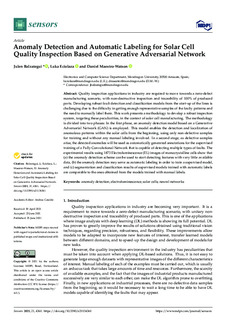Título
Anomaly Detection and Automatic Labeling for Solar Cell Quality Inspection Based on Generative Adversarial NetworkVersión
Version publicada
Derechos
© 2021 by the authors. Licensee MDPIAcceso
Acceso abiertoVersión del editor
https://doi.org/10.3390/s21134361Publicado en
Sensors Vol. 21. N. 13. N. articulo. 4361, 2021Editor
MDPIPalabras clave
anomaly detectionelectroluminescence
solar cells
neural networks
Resumen
Quality inspection applications in industry are required to move towards a zero-defect manufacturing scenario, with non-destructive inspection and traceability of 100% of produced parts. Developing ro ... [+]
Quality inspection applications in industry are required to move towards a zero-defect manufacturing scenario, with non-destructive inspection and traceability of 100% of produced parts. Developing robust fault detection and classification models from the start-up of the lines is challenging due to the difficulty in getting enough representative samples of the faulty patterns and the need to manually label them. This work presents a methodology to develop a robust inspection system, targeting these peculiarities, in the context of solar cell manufacturing. The methodology is divided into two phases: In the first phase, an anomaly detection model based on a Generative
Adversarial Network (GAN) is employed. This model enables the detection and localization of anomalous patterns within the solar cells from the beginning, using only non-defective samples for training and without any manual labeling involved. In a second stage, as defective samples arise, the detected anomalies will be used as automatically generated annotations for the supervised training of a Fully Convolutional Network that is capable of detecting multiple types of faults. The experimental results using 1873 Electroluminescence (EL) images of monocrystalline cells show that (a) the anomaly detection scheme can be used to start detecting features with very little available data, (b) the anomaly detection may serve as automatic labeling in order to train a supervised model, and (c) segmentation and classification results of supervised models trained with automatic labels are comparable to the ones obtained from the models trained with manual labels. [-]
Sponsorship
Gobierno VascoID Proyecto
info:eu-repo/grantAgreement/GV/Elkartek 2020/KK-2020-00077/CAPV/Desarrollo de tecnologías fotovoltaicas avanzadas/ENSOL2Colecciones
- Artículos - Ingeniería [684]
El ítem tiene asociados los siguientes ficheros de licencia:























